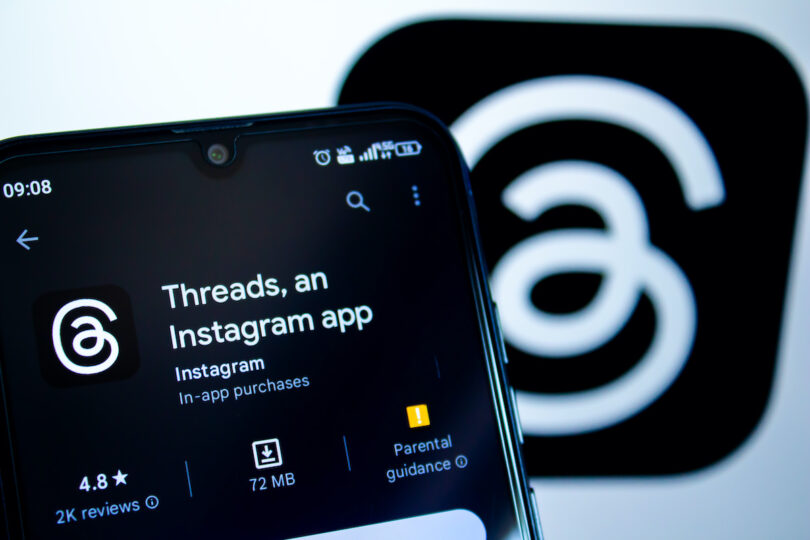With Elon Musk at the helm of Twitter (recently rebranded as X) and the continued chaos and criticism surrounding the company, Meta has seized the opportunity to unveil Threads, its own microblogging platform, to rival Twitter’s dominance. But the question remains: Will Threads become the new Twitter or fizzle out like Clubhouse?
Assess these nine factors to decide if your brand or organization should lean in or out of Threads.
1. How Threads works
Let’s start with the basics: Threads is 100% mobile-based. Your brand will need an existing Instagram account to sign up, as Threads is closely tied to its sibling app. Once in, you’ll find familiar features, including liking, reposting, replying and so on. With a generous 500-character limit per post, Threads provides more room for copy than Twitter’s 280-character restriction. Plus, Threads allows up to 10 photos per post (vs. Twitter’s stingy four) and videos of up to five minutes each.
Threads is an easy option for existing Instagram users. Brands can transfer their profile, accounts followed and content preferences at the click of a button. However, followers cannot be transferred and must choose to follow a brand (or any user) separately on Threads. While brands can share links to Threads posts on Instagram stories and its bio to cultivate a following, you’re still annoyingly starting from scratch.
2. A glimpse into a portable social identity
Despite this new functionality to transfer data between platforms, Meta remains a closed system. However, Meta has expressed intentions to integrate with an open social media protocol called ActivityPub (which will also enable followers to be transferred).
This potential shift could revolutionize social media by allowing users (and brands) to carry their social identity across platforms seamlessly. While platforms are not currently incentivized to adopt ActivityPub, it would enable broader innovation across social media if users with established followings were no longer trapped by a platform and beholden to its algorithm changes.
3. Users are intrigued, but not committed
Threads made an impressive entry with 100 million people signing up for the app in less than a week. According to SimilarWeb, Threads’ daily active user count dropped from 49 million to 12 million within three weeks, raising questions about its lasting appeal. So Threads has not made it into users’ daily social media routine — yet.
4. Brand building and community engagement
Threads is reminiscent of the early days of social media, where the focus was on great content and brand building (not selling). Threads allows brands to relive those glory days by showing off their personalities and making authentic connections with their community.
Prominent brands (Nike and Wendy’s) and celebrities (Oprah and Kim Kardashian) have already embraced Threads for these purposes. However, it’s interesting and unexpected that pharmaceutical companies that are usually late social media adopters have already jumped on the Threads bandwagon (Boehringer Ingelheim, Moderna, Bayer and Amgen.)
5. Early adopters may reap long-term rewards
As observed with previous social media platforms, the strategic decision to become an early adopter can yield significant advantages for brands. Similar to how brands that embraced platforms like Instagram and TikTok early on gained an edge. By aligning with Threads from its inception, brands have the opportunity to carve a distinct niche and build a loyal following within the evolving platform ecosystem.
Early adopters often benefit from the momentum generated as the platform gains traction, allowing them to establish strong connections with the initial user base. This can translate into long-term brand loyalty and deeper community engagement.
6. Limited content discovery
Part of being an early adopter is dealing with platform limitations. Threads lacks essential content discovery features like keyword search, hashtags and trends. This limitation inhibits a brand’s ability to explore and engage with a broader range of content. Considering Meta’s ambitions to replace Twitter, it’s likely that these limitations will be addressed sooner than later. (Updated Aug. 22: Meta has introduced a web version of Threads.)
7. Paid options
Although Threads is ad-free, Meta has big plans to incorporate paid options soon as more advertisers distance themselves from Twitter. With Morningstar analysts already predicting that Threads advertising revenue could range between $2-3 billion annually, marketers are unlikely to have to wait long for paid options.
8. Organic social focus
Threads’ current lack of paid options and comprehensive analytics restricts its usage to organic social strategies. While this may limit immediate marketing capabilities, it also creates a significant PR opportunity. Encouraging genuine interactions and authentic brand-customer relationships are both ideal for driving awareness and establishing trust.
9. Twitter in Europe
Despite Threads’ organic focus being perfect for the European Union, where branded communications can be limited in regulated industries, the platform has been unable to launch to the block. The EU enforces rigorous data and privacy rules that don’t jive with Meta’s modus operandi of collecting a wide range of personal information, including health, financial, contacts, browsing and search history, location data, purchases and “sensitive” info. With that said, Threads is live in Apple and Google Android app stores in more than 100 countries, including the United States, the U.K., Australia, Canada and Japan.
Whether Threads becomes the new Twitter or joins the ranks of fads is a question that only time will answer. If the resources are available and Europe is not a key market, then it’s probably advantageous to lean into Threads but don’t delete your Twitter account — yet.
Shalon Kerr (née Roth) is an award-winning author and has contributed to several PR trade publications. In 2018, she founded PR-it, a health care PR firm powered by a global collective of independent experts who are curated into virtual dream teams to help biotech, pharma and health care companies/brands reach their goals through strategic public relations, health care communications and marketing magic.
[emre akkoyun]






